Introduction
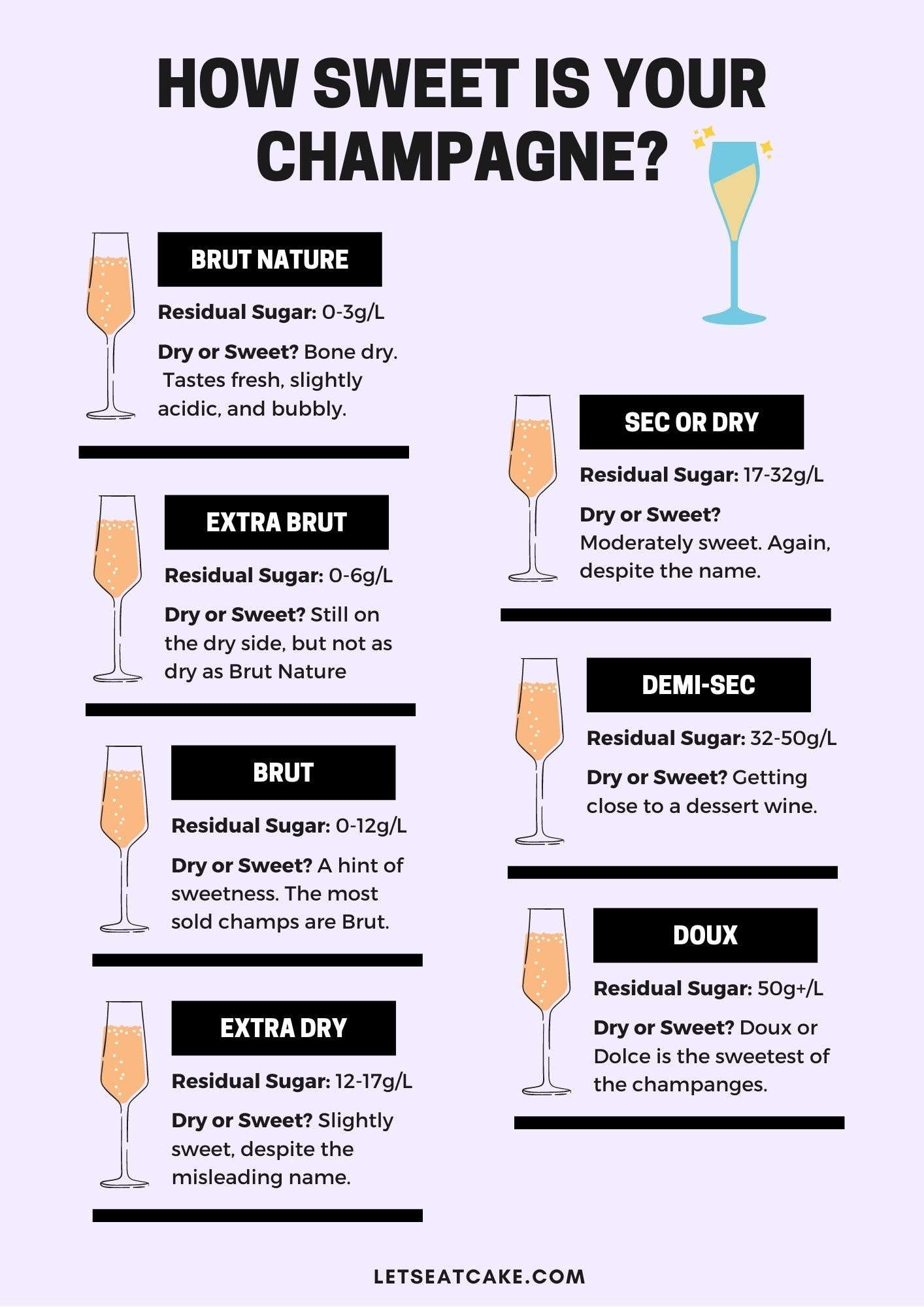
Champagne is a beloved and iconic sparkling wine that has become synonymous with celebration and luxury. Within the world of Champagne, there are various styles to choose from, including Brut and Extra Dry. These terms, often misunderstood, actually refer to the sweetness level of the wine. Despite their similar names, Brut and Extra Dry Champagne represent two distinct styles with different characteristics and flavor profiles. Understanding the differences between the two can help you choose the perfect Champagne for your taste preferences and occasion. In this blog post, we will delve into the details of Brut and Extra Dry Champagne to help you make an informed choice.
Brief Overview Of Champagne And Its Different Styles
Champagne is a renowned sparkling wine that originates from the Champagne region of France. It is traditionally made using the méthode champenoise, which involves a second fermentation in the bottle to create carbonation. Champagne comes in various styles, each with its own unique characteristics. Apart from Brut and Extra Dry, other popular styles include Demi-Sec (slightly sweet), Sec (medium sweet), and Doux (very sweet). These styles are differentiated by their sweetness levels, ranging from bone-dry to sweet. Understanding these differences allows wine enthusiasts to choose a Champagne that suits their taste preferences and the occasion at hand.
Brut Champagne
Brut Champagne is a popular style known for its dryness and crispness. It is the driest of all Champagne styles, with minimal residual sugar. The term “brut” translates to “raw” or “unrefined,” and it represents a clean and pure expression of the Champagne region. Brut Champagne offers refreshing acidity and a wide range of flavors, including citrus, green apple, and toast. It is a versatile option that pairs well with a variety of foods, from seafood to roasted poultry. Some renowned Brut Champagne brands include Moët & Chandon, Veuve Clicquot, and Dom Pérignon.
Characteristics And Flavor Profile Of Brut Champagne
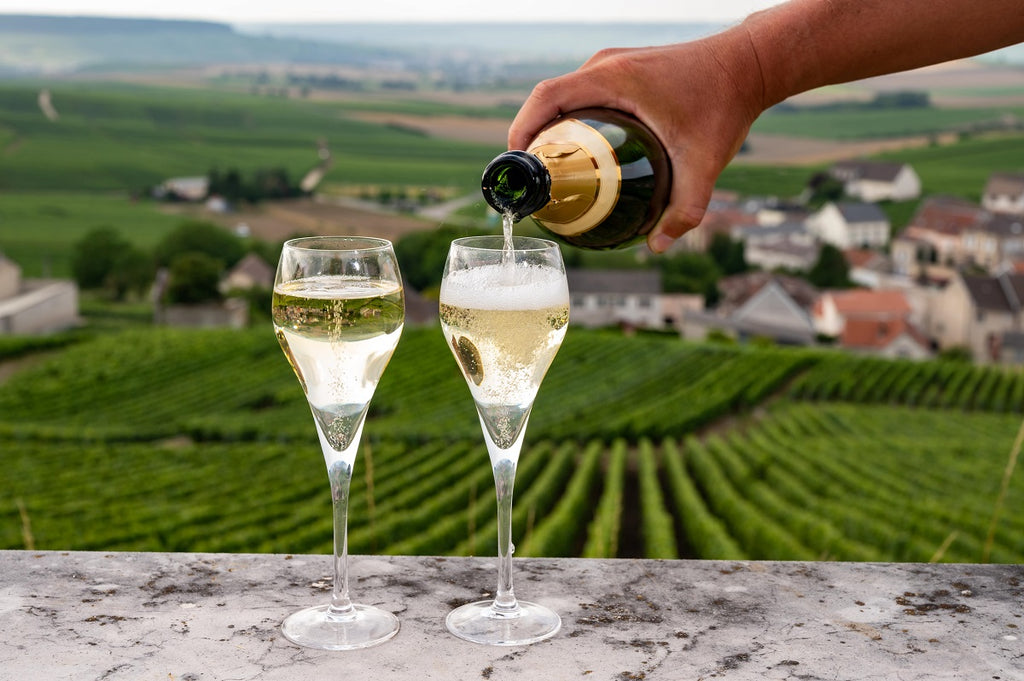
Brut Champagne is characterized by its dryness and crispness. It is the driest of all Champagne styles, with minimal residual sugar. This results in a clean and pure expression of the Champagne region. The flavor profile of Brut Champagne is refreshing and vibrant, with notes of citrus, green apple, and toast. It offers a lively acidity and a fine, persistent bubble. The overall taste is elegant and balanced, making it a versatile option that can be enjoyed on its own or paired with a variety of foods.
Popular Brut Champagne Brands
Some popular Brut Champagne brands include Moët & Chandon, Veuve Clicquot, Dom Pérignon, Krug, and Bollinger. These renowned Champagne houses are known for their exceptional quality and consistent production of Brut Champagnes. Moët & Chandon, for instance, offers the iconic Moët & Chandon Impérial Brut, known for its impeccable balance and vibrant fruitiness. Veuve Clicquot’s Brut Yellow Label is another widely recognized and beloved Brut Champagne, characterized by its rich, toasty flavors and long-lasting finish. Dom Pérignon, Krug, and Bollinger are also highly regarded for their exquisite Brut offerings, making them go-to choices for Champagne enthusiasts worldwide.
Extra Dry Champagne
Extra Dry Champagne is a category of sparkling wine that falls between Brut and Sec in terms of sweetness level. Despite its name, Extra Dry Champagne is actually slightly sweeter than Brut Champagne. It offers a touch of sweetness balanced by refreshing acidity, giving it a rounder and more approachable profile. Extra Dry Champagne is favored by those who prefer a hint of sweetness without it being overly cloying. Some notable producers of Extra Dry Champagne include Taittinger, Laurent-Perrier, and Perrier-Jouët. Their Extra Dry Champagnes showcase elegance, complexity, and a delicate balance between sweetness and acidity.
Unique Characteristics And Sweetness Level Of Extra Dry Champagne
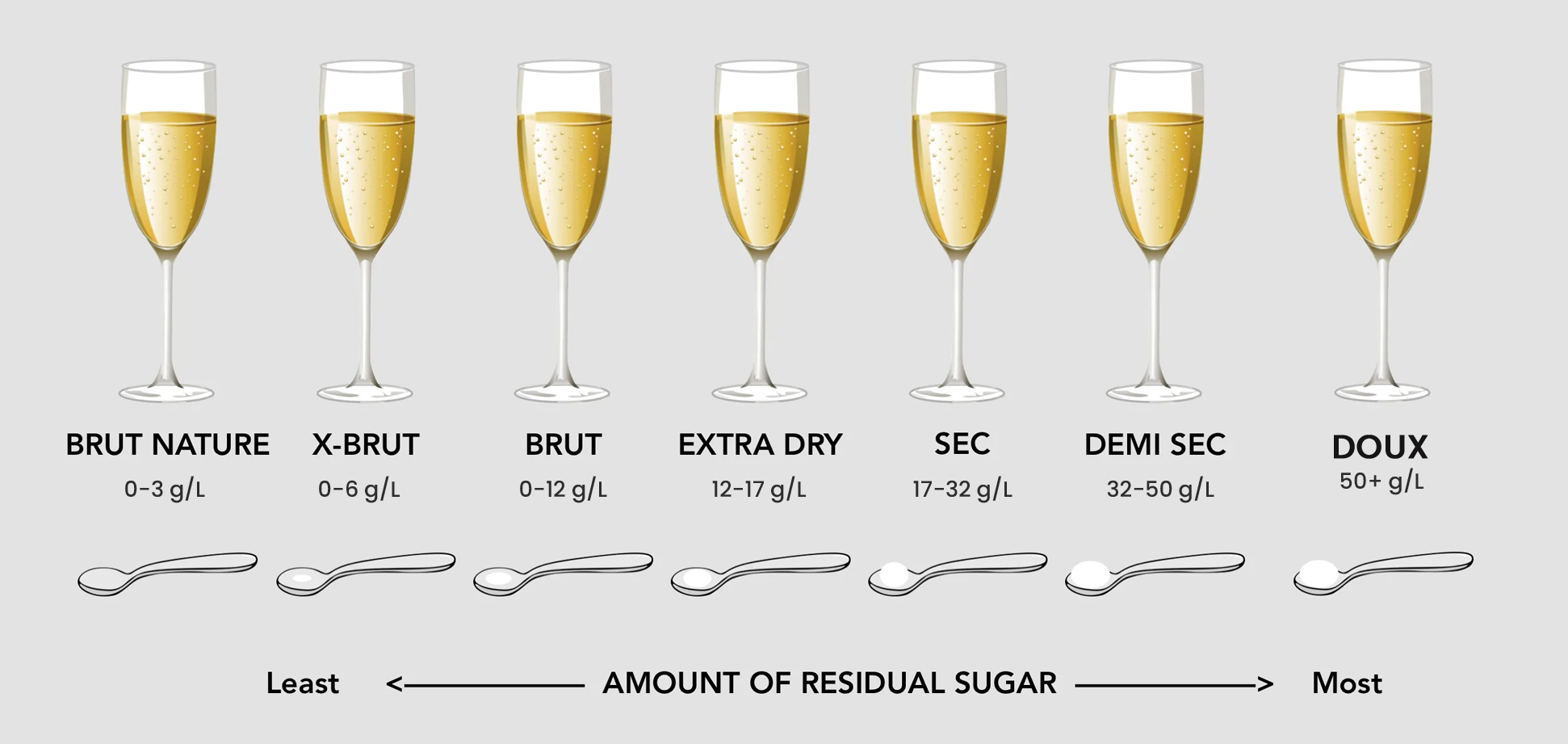
Extra Dry Champagne, despite its name, is actually slightly sweeter than Brut Champagne. It offers a unique combination of sweetness and refreshing acidity, creating a rounded and approachable profile. Extra Dry Champagne strikes a balance between sweetness and dryness, making it a versatile choice for those who prefer a hint of sweetness without it being overly cloying. With its delicate bubbles and complex flavors, Extra Dry Champagne showcases elegance and sophistication. Notable producers like Taittinger, Laurent-Perrier, and Perrier-Jouët excel in crafting Extra Dry Champagnes that exhibit complexity, finesse, and a delicate balance of flavors.
Notable Extra Dry Champagne Producers
Notable Extra Dry Champagne producers include renowned Champagne houses such as Taittinger, Laurent-Perrier, and Perrier-Jouët. Taittinger, founded in 1734, is known for producing exquisite Extra Dry Champagnes that boast elegance, finesse, and a delicate balance of flavors. Laurent-Perrier, established in 1812, is celebrated for their Extra Dry Champagnes that offer a harmonious combination of sweetness and acidity. Perrier-Jouët, founded in 1811, is esteemed for crafting Extra Dry Champagnes with complex aromas and a refined palate. These producers have mastered the art of creating Extra Dry Champagne that exemplifies excellence and sophistication.
Key Differences
The key differences between Brut and Extra Dry Champagne lie in their sweetness levels and flavor profiles. Brut Champagne is known for its dryness and crispness, with very little residual sugar. On the other hand, Extra Dry Champagne has a touch of sweetness and roundness, offering a more balanced and slightly richer palate. While both styles can be enjoyed on their own or paired with various dishes, the choice between Brut and Extra Dry ultimately comes down to personal preference. Whether you prefer the sharpness of Brut or the subtle sweetness of Extra Dry, there is a Champagne style to suit every taste.
Contrasting Features Of Brut And Extra Dry Champagnes
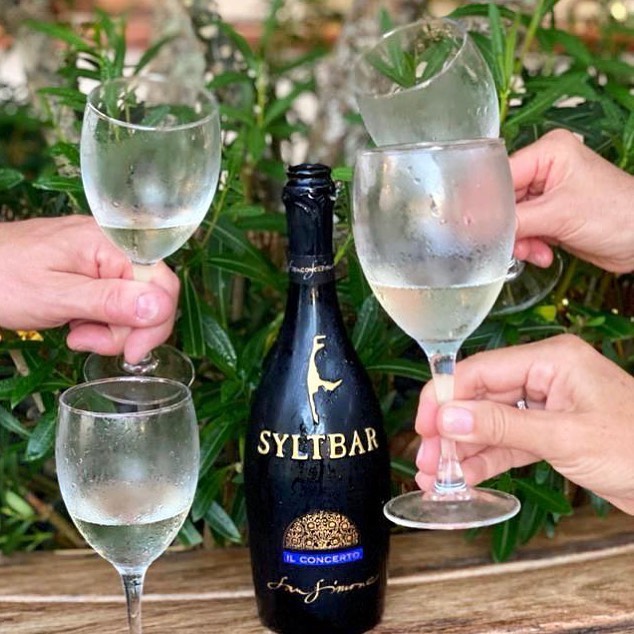
Brut and Extra Dry Champagnes offer distinct differences in terms of sweetness and flavor profiles. Brut Champagne is characterized by its dryness and crispness, with minimal residual sugar. It is known for its sharp and refreshing taste, making it a popular choice for those who prefer a drier style. In contrast, Extra Dry Champagne offers a touch of sweetness and roundness, striking a balance between dryness and sweetness. It has a slightly richer palate, providing a more indulgent and harmonious experience. The choice between Brut and Extra Dry Champagne ultimately comes down to personal preference and desired taste profile.
When To Choose Brut Over Extra Dry And Vice Versa
When it comes to choosing between Brut and Extra Dry Champagne, the decision ultimately depends on personal preference and the occasion. Brut Champagne, with its dry and crisp profile, is ideal for those who prefer a drier style and enjoy its sharp and refreshing taste. It pairs well with a wide range of foods and is often the go-to choice for celebratory toasts. On the other hand, Extra Dry Champagne, with its touch of sweetness and roundness, offers a more indulgent and harmonious experience. It is a great choice for those who enjoy a slightly richer palate and prefer a balanced sweetness. Whether you choose Brut or Extra Dry Champagne, both styles can elevate your celebratory moments and add sparkle to any occasion.
Serving And Pairing
When it comes to serving Champagne, it is important to consider the proper temperatures for both Brut and Extra Dry styles. Brut Champagne is best served chilled, between 45-50°F (7-10°C), to highlight its crisp and refreshing qualities. Extra Dry Champagne, on the other hand, should be served slightly warmer, between 50-55°F (10-13°C), to enhance its roundness and balanced sweetness.
When it comes to food pairings, Brut Champagne is a versatile option that pairs well with a wide range of dishes. It complements seafood, such as oysters and shrimp, as well as delicate appetizers, like canapés and cheese platters.
On the other hand, Extra Dry Champagne pairs well with slightly richer and creamier foods. It can be enjoyed with roasted chicken, creamy pasta dishes, and seafood with buttery sauces.
By serving and pairing these Champagne styles appropriately, you can enhance the overall enjoyment of your bubbly experience. Cheers! [22
Proper Serving Temperatures For Brut And Extra Dry Champagnes

To fully appreciate the flavors and aromas of Brut and Extra Dry Champagnes, it’s important to serve them at the proper temperatures. Brut Champagne should be chilled to a temperature of 45-50°F (7-10°C). This cool temperature allows the crisp and refreshing qualities of the Champagne to shine. On the other hand, Extra Dry Champagne should be served slightly warmer, between 50-55°F (10-13°C). This slightly higher temperature helps enhance the roundness and balanced sweetness of the wine. By serving these Champagne styles at their respective temperatures, you can ensure an optimal drinking experience.
Ideal Food Pairings For Each Champagne Style
Brut Champagne, with its crisp acidity and dry finish, pairs perfectly with a variety of dishes. It complements seafood like oysters and shrimp, as well as light appetizers such as bruschetta or goat cheese crostini. The refreshing acidity of Brut Champagne also harmonizes well with sushi and sashimi. On the other hand, Extra Dry Champagne’s subtle sweetness makes it a great match for slightly richer dishes. It pairs beautifully with foie gras and pâtés, roasted poultry, and creamy desserts like crème brûlée. The balanced sweetness of Extra Dry Champagne adds a delightful touch to these decadent flavors. So whether you’re serving light or indulgent dishes, there’s a Champagne style to enhance your culinary experience.
Conclusion
In conclusion, understanding the difference between Brut and Extra Dry Champagne allows wine enthusiasts to make an informed choice based on their taste preferences and the occasion. Brut Champagne is known for its dryness and crispness, while Extra Dry Champagne offers a touch of sweetness and roundness. Both styles have their unique qualities that can enhance celebratory moments or pair beautifully with various culinary delights. Exploring different producers and cuvées can help discover the nuances and individual styles that suit one’s palate. Whether it’s a special occasion or simply indulging in a glass of bubbles, choosing the right Champagne style adds an extra layer of enjoyment to the experience.
Summary Of The Differences Between Brut And Extra Dry Champagnes
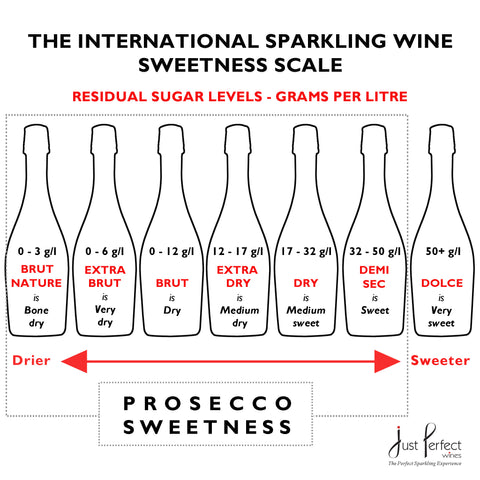
Brut Champagne and Extra Dry Champagne are both popular styles of Champagne with distinct differences. Brut Champagne is known for its dryness and crispness, with minimal sweetness and a focus on acidity. On the other hand, Extra Dry Champagne, despite its name, is actually sweeter than Brut Champagne, with a higher dosage of sugar added during production. It offers a touch of sweetness and roundness to balance the acidity. When choosing between the two, it ultimately comes down to personal preference and the desired level of sweetness in the Champagne.
Final Thoughts On Choosing The Right Champagne Style For Your Preferences.
When it comes to choosing the right Champagne style for your preferences, there are a few key factors to consider. First and foremost, determine your sweetness preference. If you prefer a drier wine with minimal sweetness, Brut Champagne is the way to go. However, if you enjoy a touch of sweetness without it being overpowering, Extra Dry Champagne is the perfect choice. Additionally, consider the occasion and food pairings. Brut Champagne’s acidity and dry finish make it a great match for seafood and light appetizers, while the slight sweetness of Extra Dry Champagne complements richer dishes. Ultimately, exploring different producers and cuvées will help you discover the nuances and individual styles that suit your palate.
FAQ About Brut Vs Extra Dry: Comparing Champagne Styles
Q: What is the main difference between Brut and Extra Dry Champagne?
A: The main difference lies in their sweetness levels. Brut Champagne is drier than Extra Dry Champagne, with less residual sugar content.
Q: How does the sweetness level in Brut and Extra Dry Champagne affect their taste?
A: Brut Champagne tends to be crisper and less sweet, showcasing more acidity and allowing the natural flavors of the grapes to shine. Extra Dry Champagne, despite its name, actually has a slightly sweeter taste due to the higher sugar content.
Q: Which occasions are more suitable for serving Brut Champagne?
A: Brut Champagne, being less sweet and more refreshing, is ideal for celebrations, toasts, and pairing with various foods like seafood, sushi, and light appetizers.
Q: When should one opt for Extra Dry Champagne instead of Brut?
A: Extra Dry Champagne can be a great choice for individuals who prefer a slightly sweeter taste or for pairing with desserts that are not overly sweet, such as fruit-based desserts.
Q: Are Brut and Extra Dry Champagne interchangeable in cocktails?
A: While both Brut and Extra Dry Champagne can be used in cocktails, their different sweetness levels will impact the overall taste of the cocktail. It’s best to choose the one that aligns with the desired sweetness profile of the cocktail being made.
Q: Do Brut and Extra Dry Champagne come from different grape varieties or regions?
A: Both Brut and Extra Dry Champagnes can be produced from the same grape varieties and regions within Champagne, France. The distinction in sweetness levels is primarily determined during the winemaking process through dosage, the addition of a sugar mixture.
Q: How can one determine whether a Champagne is Brut or Extra Dry?
A: The sweetness level of a Champagne is indicated on the label. A Brut Champagne typically has a sugar content of up to 12 grams per liter, while an Extra Dry Champagne can have around 12 to 17 grams per liter, making it slightly sweeter.

Let’s be honest—Parma, OH has its fair share of neighborhood joints, as do the surrounding Cleveland suburbs. There are bar food offerings, happy hour, and an enjoyable environment in which to watch the Tribe and Browns.
With Sidekicks Tavern, though, you get all that and then some. You get a bar menu, a warm staff, and a great group of fun customers to hang with.
In the words of one of our favorite regulars, Sidekicks is a hidden gem.